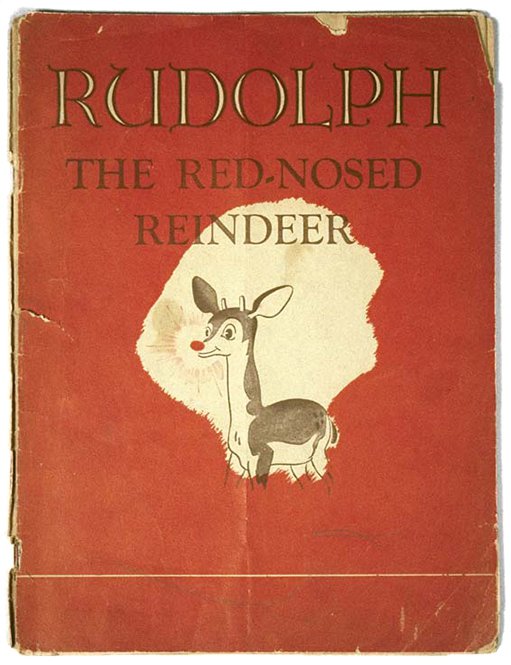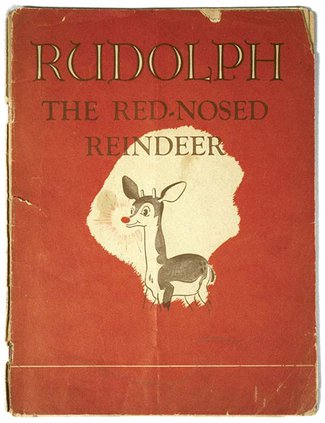Each week we’ll take a step back into the history of Great Bend through the eyes of reporters past. We’ll reacquaint you with what went into creating the Great Bend of today, and do our best to update you on what “the rest of the story” turned out to be.
This time of year, it’s not unusual for department stores to offer that one must-have item that we know will light up that special kid or kids in our lives, and it’s so inexpensive, we just can’t resist. For some stores, it’s linked to a charitable campaign. But probably one of the most famous, most long-lasting, most impactful Christmas giveaways in the history of American retail shopping was the creation of Rudolph the Red Nosed Reindeer.
And perhaps, as Rudolph marks his 80th birthday this year, you’ve heard the story of how he was the creation of Robert May, one of the staff copywriters for the department store Montgomery Wards in Chicago. The family had moved there after May’s wife’s family lost its wealth following the stock market crash of 1929. The company felt it could save money and publish its own book instead of paying for a coloring book giveaway during the holidays as it had for the previous 15 years, according to the page devoted to Robert May on Wikipedia. For May, it was a chance to make some much needed extra money, and a much needed creative outlet.
In 1939, with a dying wife and children to care for, his employer offered to take him off the project, but he insisted on seeing it through, and the rest is history. You can learn more at Smithsonian Insider, https://insider.si.edu/2010/12/montgomery-ward-department-store-rudolph-the-red-nosed-reindeer-book-1939/


Provisions for Christmas
May’s family likely spent a bittersweet Christmas together in 1939, their first without wife and mother Evelyn May after her passing from cancer. Along with the tears, there were likely financial obligations to be met that resulted in a lean Christmas for the kids. They, like many across the nation, were not alone. The Barton County welfare director, B.H. Asher, announced the receipt of 51 boxes of high quality apples from the State of Oregon, which would be distributed to the poor of Barton County in special Christmas baskets and gifts handled by local charity groups, the Tribune reported early in the week.
Apples weren’t the only thing these 170 families could look forward to that Christmas season. Boy Scouts were busy repairing toys and packing them in boxes for distribution before the big day.
Members of the community stepped up to provide food and something extra to most of the families, and Mrs. Lucy Morrison, the clearing agent for the Associated Charities, was hopeful the remaining 15 to 20 families would be accounted for before Christmas Eve. She could be reached, it was reported, in the Rest Room of the county courthouse. (Back in the day, the rest-rooms in area courthouses included sofas, chairs, facilities for lounging and visiting in addition to relieving oneself. It was a welcome service for travelers who regularly commuted by train or were dropped off for a day in town. Remember, not everyone had a car, and women, especially, were transportation challenged.)
On Christmas day, the Tribune reported “Merry Christmas” was the cheery greeting heard at every Great Bend home that day as basket after basket was delivered to the homes of less fortunate persons in the community.
“Of course the baskets included the necessary ingredients for a fancy meal and in most cases there were some clothes and toys according to the needs and wants of the family receiving the basket.”
The Boy Scouts had prepared enough toys to fill up to 200 baskets, so Morrison spread the word that families in need of toys could contact her and she would be happy to share what was left.
The tradition of reaching out and sharing good fortune during the holidays continues throughout Barton County today. Last week, volunteers gathered around the counties to wrap hundreds of presents received from those who chose names from Angel Trees in each community, and the gifts were picked up and dropped off with individuals in time for Christmas. According to United Way of Central Kansas Executive Director Gaila Demel, this year, there were fewer families in need than in recent years.
Robl’s missing deer
One well-known Barton County man was on the lookout for his pet deer around the time Santa was in the air with his own.
On Dec. 10, 1939, a Kansas story made The New York Times, concerning a deer in Kingman that was chased to death. Ellinwood’s Frank Robl worried the same fate might face escaped Virginia white tailed deer that he’d been keeping for the past four years on his farm property three miles north of Ellinwood in Barton County. Two does and a buck were believed to be somewhere near there, and Robl went to the Tribune to get the word out to readers in hopes they would inform him of their whereabouts. The fact that they’d been kept as pets had made them tame, he noted.
It is unknown what happened to the deer, but Robl himself was already well on his way to becoming a local legend as a renowned duck bander, having banded more than 10,000 ducks between 1924 and 1934 as part of a national biological survey. Because of his work, it was determined that Cheyenne Bottoms lay on the North American Central Fly Way for migrating birds, which led to it being declared a Wetland of International Importance.
Peace observed
On Dec. 25, the Tribune’s publishers made an editorial decision to limit bad news.
“Mindful that Christmas is an occasion for good tidings, the Tribune today has held its war, accident and crime news to a minimum. Dispatches of this character also have been allotted an inside page position. Today’s Tribune was published last night so that employees might join with their families in the festivities of the day.”
Some of the Tribune’s paper carriers delivered papers during the early morning hours of Christmas Day that year. Today, employees as a whole observe the Christmas holiday with their families. For several years, the Tribune has not been published on Christmas, and that continues this year. Instead, we will publish a paper on Tuesday, Dec. 24, followed by a Friday, Dec. 27 edition.
Just for fun
News of “shortest day”
December 21, 1939, was the shortest day of the year, the Tribune reported on Dec. 22. Coincidentally, it will have also been the shortest day of the year in 2019. The explanation, according to the Dec. 22, 1939, edition of the Tribune: it is the date when the sun seems to reach the southernmost point on its annual journey and pauses a little before it starts back towards the north.





